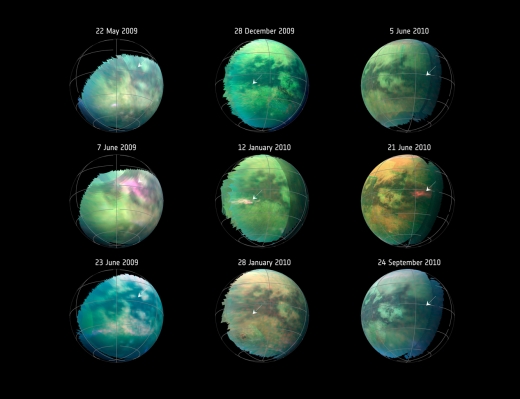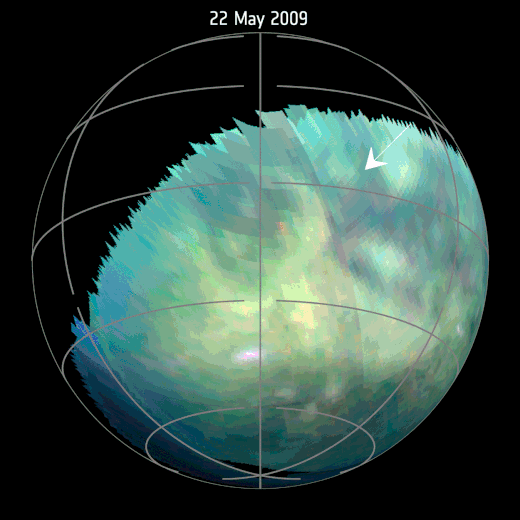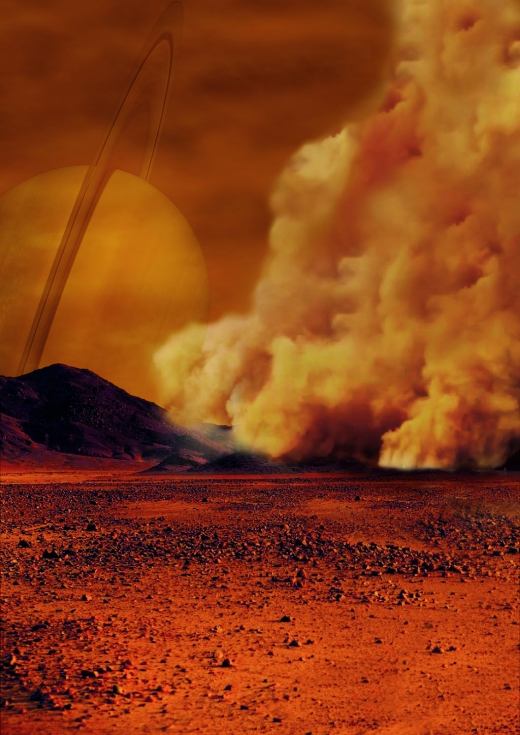I always imagined Titan’s surface as a relatively calm place, perhaps thinking of the Huygens probe in an exotic, frigid landing zone that I saw as preternaturally still. Then, prompted by an analysis of what may be dust storms on Titan, I revisited what Huygens found. It turns out the probe experienced maximum winds about ten minutes after beginning its descent, at an altitude of some 120 kilometers. It was below 60 kilometers that the wind dropped. And during the final 7 kilometers, the winds were down to a few meters per second. At the surface, according to the European Space Agency, Huygens found a light breeze of 0.3 meters per second.
But is Titan’s surface always that quiet? The Cassini probe has shown us that Titan experiences interesting weather driven by a methane cycle that operates at temperatures far below Earth’s water cycle, filling its lakes and seas with methane and ethane. The evaporation of hydrocarbon molecules produces clouds that lead to rain, with conditions varying according to season. Conditions at the time of the equinox, with the Sun crossing Titan’s equator, are particularly lively, producing massive clouds and storms in the tropical regions.
So a lot can happen here depending on where and when we sample. Sebastien Rodriguez (Université Paris Diderot, France) and colleagues noticed unusual brightenings in infrared images made by Cassini near the moon’s 2009-2010 northern spring equinox. The paper refers to these as “three distinctive and short-lived spectral brightenings close to the equator.”
The first assumption was that these were clouds, but that idea was quickly discounted. Says Rodriguez:
“From what we know about cloud formation on Titan, we can say that such methane clouds in this area and in this time of the year are not physically possible. The convective methane clouds that can develop in this area and during this period of time would contain huge droplets and must be at a very high altitude — much higher than the 6 miles (10 kilometers) that modeling tells us the new features are located.”

Image: This compilation of images from nine Cassini flybys of Titan in 2009 and 2010 captures three instances when clear bright spots suddenly appeared in images taken by the spacecraft’s Visual and Infrared Mapping Spectrometer. The brightenings were visible only for a short period of time — between 11 hours to five Earth weeks — and cannot be seen in previous or subsequent images. Credit: NASA/JPL-Caltech/University of Arizona/University Paris Diderot/IPGP.
In a paper just published in Nature Geoscience, the researchers likewise discount the possibility that Cassini had detected surface features, areas of frozen methane or lava flows of ice. The problem here is that the bright features in the infrared were visible for relatively short periods — 11 hours to 5 weeks — while surface spots should have remained visible for longer. Nor do they bear the chemical signature expected from such formations at the surface.

Image: This animation — based on images captured by the Visual and Infrared Mapping Spectrometer on NASA’s Cassini mission during several Titan flybys in 2009 and 2010 — shows clear bright spots appearing close to the equator around the equinox that have been interpreted as evidence of dust storms. Credit: NASA/JPL-Caltech/University of Arizona/University Paris Diderot/IPGP.
Rodriguez and team used computer modeling to show that the brightened features were atmospheric but extremely low, forming what is in all likelihood a thin layer of solid organic particles. Such particles form because of the interaction between methane and sunlight. Because the bright features occurred over known dune fields at Titan’s equator, Rodriguez believes that they are clouds of dust kicked up by wind hitting the dunes.
“We believe that the Huygens Probe, which landed on the surface of Titan in January 2005, raised a small amount of organic dust upon arrival due to its powerful aerodynamic wake,” says Rodriguez. “But what we spotted here with Cassini is at a much larger scale. The near-surface wind speeds required to raise such an amount of dust as we see in these dust storms would have to be very strong — about five times as strong as the average wind speeds estimated by the Huygens measurements near the surface and with climate models.”

Image: Artist’s concept of a dust storm on Titan. Researchers believe that huge amounts of dust can be raised on Titan, Saturn’s largest moon, by strong wind gusts that arise in powerful methane storms. Such methane storms, previously observed in images from the international Cassini spacecraft, can form above dune fields that cover the equatorial regions of this moon especially around the equinox, the time of the year when the Sun crosses the equator. Credit: NASA/ESA/IPGP/Labex UnivEarthS/University Paris Diderot.
In reaching this conclusion, the researchers analyzed Cassini spectral data and deployed atmospheric models and simulations to show that micrometer-sized solid organic particles from the dunes below were responsible, an indication of dust in the atmosphere that far exceeds what Huygens found at the surface. The winds associated with the phenomenon would be unusually strong, but could be explained by downbursts in the equinoctial methane storms.
If dust storms can be created by such winds, then Titan’s equatorial regions are still active, with the dunes undergoing constant change. We have a world that is active not only in its hydrocarbon cycle and its geology, but also in what we can call its ‘dust cycle.’ The only moon in the Solar System with a dense atmosphere and surface liquid offers yet another analogy with Earth, a similarity that highlights the complexity of this frigid, hydrocarbon-rich world.
The paper is Rodriguez et al., “Observational evidence for active dust storms on Titan at equinox,” Nature Geoscience 24 September 2018 (abstract).



Nasa is considering a octocopter drone to explore Titans equator. Statically charged hydrocarbon sand may foul Dragons propulsion, sampling and sensor units.
https://www.nature.com/articles/543592b
Can’t find a full text version of the study so here an article with statements from the lead researcher.
https://www.news.gatech.edu/2017/03/27/electric-sands-titan
A comet or Titan: The next New Frontiers mission
NASA will select next year either a comet sample return mission or a spacecraft to Saturn’s moon Titan as its next New Frontiers medium-sized planetary mission. Van Kane describes the two missions and the science they would perform.
Monday, September 24, 2018
http://thespacereview.com/article/3574/1
There are also those pushing for a submarine. I prefer the drone idea, which could drop sample probes to collect sediment from the lake bottoms for analysis.
We should not have to choose. Both the drone and the submarine are fascinating and would teach us so much about Titan. Imagine the publicity they would bring to space exploration, especially the idea of a submarine exploring an alien sea made of methane and ethane.
When we look at such artist depictions, we cannot help but use Earth references and experience to “understand” it. On Mars, the low atmospheric density makes their dust storms very weak, even though they may seem like desert sandstorms.
On Titan, the “organic dust” may have a density on about the same scale as the atmosphere. Such storms may be more like the stirring up of sand or mud from the bottom of a lake. Relatively little force is required to suspend the particles in both cases. On Titan, relatively light winds, a light breeze really, may be sufficient to suspend organic detritus into what looks like a “sandstorm”.
I’m not sure about that artist’s depiction. The ring opening angle in the image looks too wide for a view from Titan, which orbits nearly in the ring plane. Also, would Saturn even be visible from the surface?
One must always have Saturn with tipped rings in any artwork depicting the Titan surface, even though in reality it is invisible due to the moon’s thick orange atmosphere. Plus Saturn’s rings would appear edge-on from Titan’s view, so no beautiful rings except a thin line.
What this demonstrates is that assumptions about surface conditions on other worlds with direct investigation is fraught with problems.
NASA considering a drone for Titan seems a little risky. We should stick to proven techniques for surface exploration, Mars has demonstrated how successful rovers can be.
Technology had moved on since the Rovers were designed and built, we need to look at Titan afresh.
A pair of orbitors, one Equatorial and one Polar, a pair of rugged Landers powered by small RTGs and wind turbines, atmospheric balloons that can stay aloft for days or weeks and perhaps each rover could have a drone that can fly for short periods and return to the lander then recharge itself.
Atmospheric balloons can be designed to operate at various levels of the atmosphere from about 5km to 120km.
We need to get creative with our missions, going to Titan is not cheap so it makes sense to maximise efforts to realise the maximum science possible.
Agree, but we need also to develop the new types of space engines (propultion or other alternatives, like solr sails), it seam to me that space exploration technology development stopped after end of Moon landing program.
Alex, it’s not so much development stopped per se, but the focus was shifted as if developing new technologies was the panacea.
The reality is massively different, NASA and ESA have become fixated on slingshot missions, but these take years to make progress, they claim it’s cost and effiency savings but it drags missions from a few years to decades and any cost savings are swallowed in costs for infrastructure and ground support.
We need to launching small rocket motors into space and parking them at the ISS, then launch missions to the ISS where they are mated to a rocket motor, propellant tank and then launched from the ISS.
It does not need to reach New Horizons velocities, but we could reach Jupiter in less than a year, Saturn in anything from18 months and so on.
Launching from orbit has the advantage than missions can be bigger as they can be pieced together from stand alone units after launch, plus reaction engines can be fitted to slow them into stable orbits upon arrival. We don’t need to be concerned with overall mass or aerodynamics if putting together in orbit.
James,
Thanks for the hint, I domehow missed the “launching from orbit” option, despite it is described multiple times in science fiction and was thought as natural direction of space exploration development.
But I think that “launching from orbit” will be more cost efective only in conditions when there will be delopped the new more cost effective way to deliver load on the Earth orbit (some type of space elevator, or new type of engine).
I do not think it can be effective with chemical rockets delivery to the orbit.
I have read that a helicopter would actually work better with Titan than a balloon when it comes to exploring. Certainly there would be more control over where it goes.
We do seem stuck in the past. What is the current status of SLS? I know this is the manned system of the future (supposedly) but how is it an improvement on the old Apollo system? And how many years off schedule is it? It doesn’t even plan for reusable engines. Where are we on new propulsion systems that can affordably and reliably deliver fairly large payloads to the outer system, and how long will it take to develop them? Are humans ever going to explore beyond the Moon? I realize ever is a long time (hopefully) but there seems to be no plan and no real drive to do the hard work going forward. I won’t even mention the Space Force idea. If one country pushes militarization of space forward others will follow. A very dangerous and pointless exercise.
NASA just came out with another new “roadmap” to space, which like so many of its recent past ones has few technical details and a heavy lack of hardware behind it:
https://spacenews.com/nasa-roadmap-report-provides-few-new-details-on-human-exploration-plans/
As I have said elsewhere before, NASA is at the same place IBM once was when other computer companies started rising up, offering PCs and laptops in place of the computer giant’s mainframe machines. IBM was able to adapt and change to stay relevant. I am wondering if NASA can do the same, especially since it relies on government funding.
As for the Space Force, it could siphon billions away from the space agency and end up with nothing to show for it. In this crazy climate I could even see NASA being assimilated to serve the needs of the USSF. Yes, I know NASA was founded as a *civilian* space agency, but as we see in the news every day, contracts and laws are made to be broken and ignored on a whim.
https://spacenews.com/inside-the-pentagon-disagreements-deepen-over-how-to-create-a-space-force/
Some key insights into yesterday’s two Senate hearings with NASA:
http://nasawatch.com/archives/2018/09/two-hearings-po.html
Thanks so much for your feedback ljk. We’re at a crucial time and seem to have extremely bad governance and a lack of leadership. This applies across virtually all disciplines. I would hate to see NASA become irrelevant, or worse, absorbed as part of the military. My efforts are mainly in the environmental area, but we need people to step forward in the space community and point out the lack of a true direction. Space isn’t a plaything for people with no training and no desire to learn about it. I won’t mention a name but I think it’s obvious who I’m referring to.
I read through the NASA links from ljk. It doesn’t look good at all to me. Very late presentations of future plans to members of Congress, and when presented containing very few actual details. Much of it often containing cartoon-like graphics. This looks like an agency in decline. They appear to be good at asking for more money for manned exploration but very poor at delivering any kind of real end result.
NASA May Decide This Year to Land a Drone on Saturn’s Moon Titan
By Meghan Bartels, Space.com Senior Writer |
January 16, 2019 at 07:37 am
The spacecraft that have peered through the yellowish haze surrounding Saturn’s moon Titan discovered a strange, yet strangely familiar world where life could theoretically take root. Now, scientists want to return — this time buoyed by Earth’s fascination with drone technology.
That’s precisely what a team of scientists working on a proposed mission called Dragonfly want to do: combine terrestrial drone technology and instruments honed by Mars exploration to investigate the complex chemical reactions taking place on Saturn’s largest moon.
Later this year, NASA will need to decide between that mission and another finalist proposal, which would collect a sample from a comet.
“At first blush, I think a lot of people think [Dragonfly] sounds like the literal meaning of incredible,” Melissa Trainer, a deputy principal investigator with the mission and a scientist at NASA, told Space.com. “Not only is this an incredibly exciting concept with amazing, compelling science, but also, it is doable — it’s feasible from an engineering standpoint.”
Full article here:
https://www.space.com/43010-dragonfly-mission-would-put-a-drone-on-titan.html
To quote:
Dragonfly, if chosen, would aim to launch in 2025 and arrive at Titan in 2034. The world it will explore is oddly reminiscent of Earth for a strange moon so far away. On Earth, sunlight powers organic life growing in fields and forests; the same sunlight triggers chemical reactions in Titan’s upper atmosphere that create large organic molecules that pour down on the moon’s surface, like Earth’s rainwater. While Earth has a landscape made of rock covered in places by water, Titan’s landscape is made of water ice covered in places by organic compounds.
New study finds evidence of changing seasons, rain on Titan’s north pole
16 January 2019
WASHINGTON — An image from the international Cassini spacecraft provides evidence of rainfall on the north pole of Titan, the largest of Saturn’s moons. The rainfall would be the first indication of the start of a summer season in the moon’s northern hemisphere.
“The whole Titan community has been looking forward to seeing clouds and rains on Titan’s north pole, indicating the start of the northern summer, but despite what the climate models had predicted, we weren’t even seeing any clouds,” said Rajani Dhingra, a doctoral student in physics at the University of Idaho in Moscow, and lead author of the new study accepted for publication in Geophysical Research Letters, a journal of the American Geophysical Union. “People called it the curious case of missing clouds.”
Dhingra and her colleagues identified a reflective feature near Titan’s north pole on an image taken June 7, 2016, by Cassini’s near-infrared instrument, the Visual and Infrared Mapping Spectrometer. The reflective feature covered approximately 46,332 square miles, roughly half the size of the Great Lakes, and did not appear on images from previous and subsequent Cassini passes.
Analyses of the short-term reflective feature suggested it likely resulted from sunlight reflecting off a wet surface. The study attributes the reflection to a methane rainfall event, followed by a probable period of evaporation.
“It’s like looking at a sunlit wet sidewalk,” Dhingra said.
Full article here:
https://news.agu.org/press-release/new-study-finds-evidence-of-changing-seasons-rain-on-titans-north-pole/